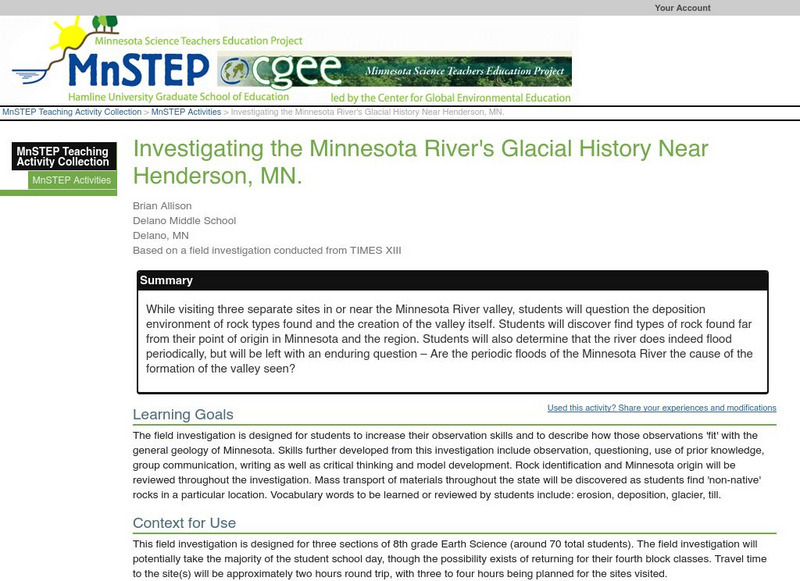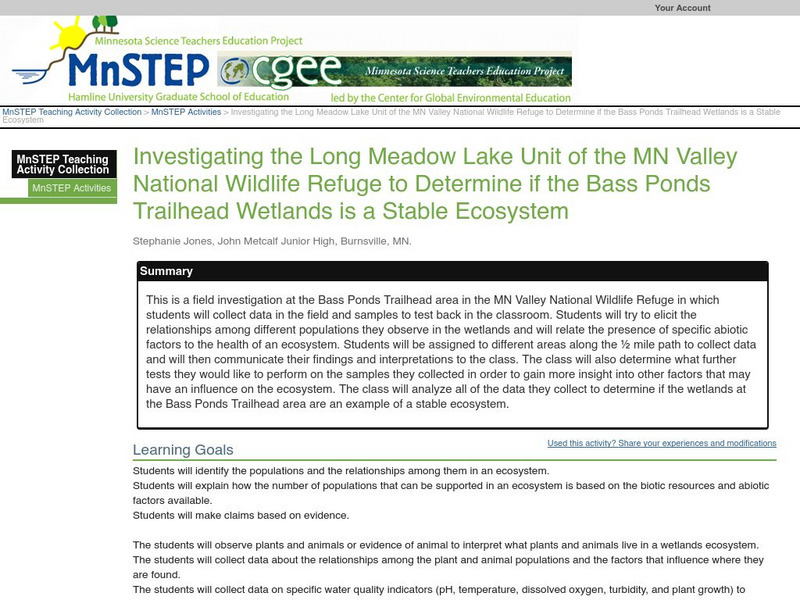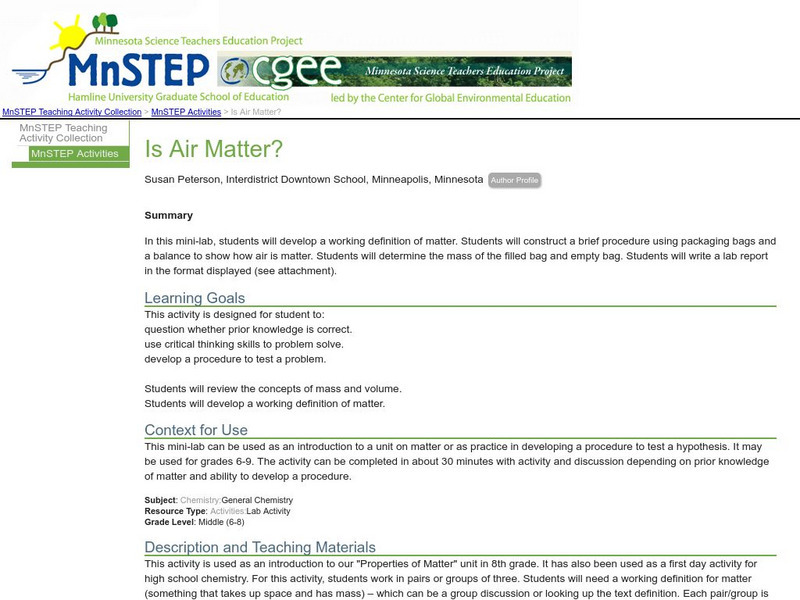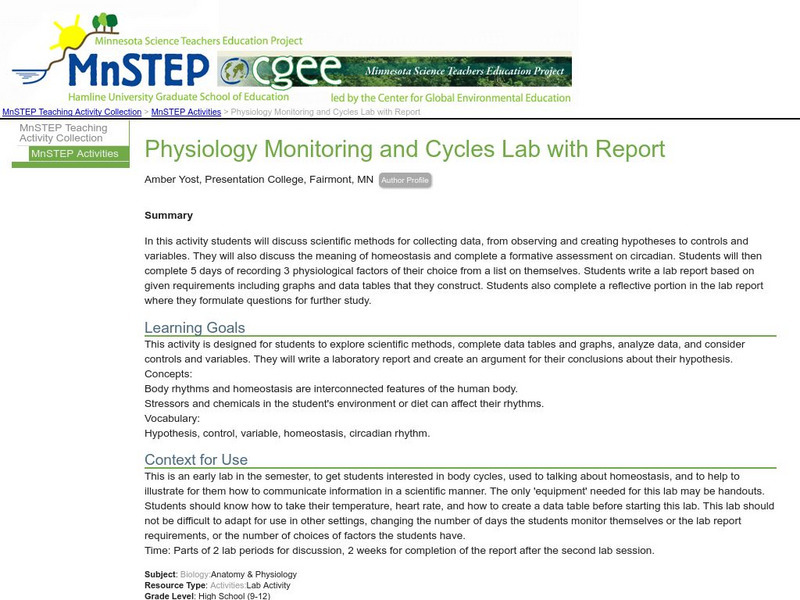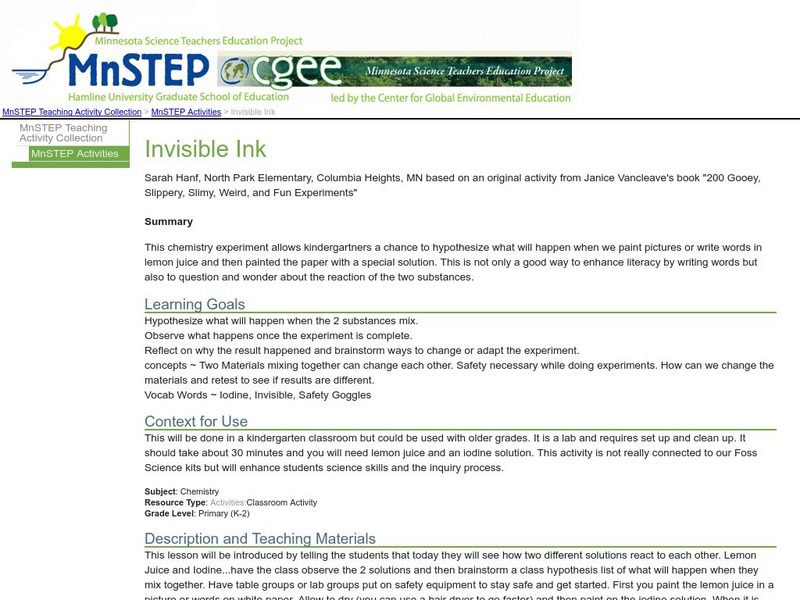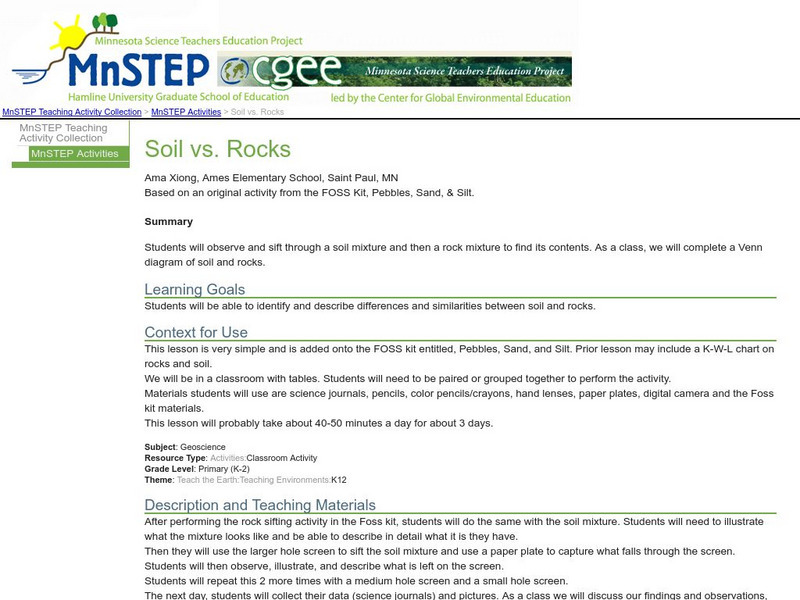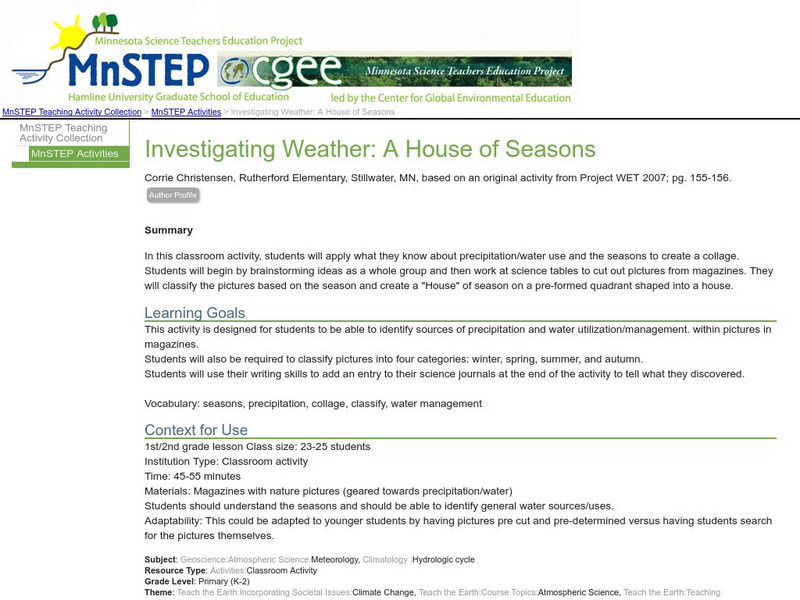Science Education Resource Center at Carleton College
Serc: Investigating the Minnesota River's Glacial History Near Henderson, Mn.
While visiting three separate sites in or near the Minnesota River valley, middle schoolers will question the deposition environment of rock types found and the creation of the valley itself. Students will discover find types of rock...
Science Education Resource Center at Carleton College
Serc: Mn Step: What Are Communicable Diseases and How Can We Prevent Them?
In this lesson, students will learn about infectious diseases caused by microorganisms, what causes them and how to protect oneself, and play a game where they play the role of a disease.
Science Education Resource Center at Carleton College
Serc: Period of a Pendulum Investigation
Using a simulation, students will determine that the pendulum period is affected by the length of the pendulum and gravity but not mass in this activity.
Science Education Resource Center at Carleton College
Serc: Investigating the Long Meadow Lake Unit of Valley Nat'l Wildlife Refuge
This is a field investigation at the Bass Ponds Trailhead area in the MN Valley National Wildlife Refuge in which learners will collect data in the field and samples to test back in the classroom. Students will try to elicit the...
Science Education Resource Center at Carleton College
Serc: Does Salt & Vinegar Have an Effect on Pennies?
During this lab students will experiment to see whether a salt and vinegar solution can clean a tarnished penny. Included on site is lesson plan and student worksheet.
Science Education Resource Center at Carleton College
Serc: The Opposable Thumb as a Human Adaptation: Thumb Taping Lab
Students conduct a short experiment to determine the importance of the opposable thumb by taping their thumb to render it useless while they proceed to do an everyday activity. In the end students will have the opportunity to reflect on...
Science Education Resource Center at Carleton College
Serc: Orienteering With Vectors
An activity where students use their knowledge of vectors to create orienteering directions for their fellow classmates to follow. The directions must contain at least 6 checkpoints and the final checkpoint includes a prize!
Science Education Resource Center at Carleton College
Serc: Phenology Weekly
A long-term project lesson plan where students observe seasonal changes by recording observations and data of the weather conditions. Students will understand how to use a light meter, thermometer, anemometer, and rain gauge with this...
Science Education Resource Center at Carleton College
Serc: Is Air Matter?
A quick lab experiment to determine if air has mass and can be considered matter. This activity can be part of a unit of matter. Lesson plan includes instructions for a format for a mini lab report and student instruction sheet.
Science Education Resource Center at Carleton College
Serc: Density With Carbon Dioxide
A guided demonstration where students investigate the properties of carbon dioxide gas and air based on density. Students learn about properties of air through observation and inquiry.
Science Education Resource Center at Carleton College
Serc: Investigating the Constancy of Gravity: Free Fall Using a Water Bottle
In this physics interactive lecture demonstration, students will predict what will happen if a plastic bottle, filled with water and having a hole near the bottom, is dropped. Will the bottle fall at the same rate as the water inside the...
Science Education Resource Center at Carleton College
Serc: Physiology Monitoring and Cycles Lab With Report
Using physiology monitoring, students will understand how to collect data using scientific methods in this activity. Students will also learn how to communicate the finding in a lab report. Physiology monitoring will include measuring...
Science Education Resource Center at Carleton College
Serc: Oil and Water Art Project
Students will create art by mixing watercolors with vegetable oil. By mixing the liquids, students can experiment the different properties of liquids. Lesson is developed to be a culminating project for a unit on liquids.
Science Education Resource Center at Carleton College
Serc: Invisible Ink
Students will get to experiment with "invisible ink" to enhance their literacy skills and their understandings of reactions between two substances.
Science Education Resource Center at Carleton College
Serc: Mn Step: What Killed Tweety? An Ecological Exploration of West Nile Virus
Students do research to learn about West Nile Virus, the birds that carry it, how it spreads, where it can be found in North America, and how it affects humans. The activity is set up as a WebQuest where students navigate to assigned...
Science Education Resource Center at Carleton College
Serc: Soil vs. Rocks
Students will compare soil and rocks by observing and sifting a soil mixture and a rock mixture. To complete the activity students will make a Venn diagram.
Science Education Resource Center at Carleton College
Serc: Our Big Backyard: How Does Our Local Ecosystem Change During the Year?
Get students observing the environment around their school with this activity. In this lab experiment, students keep a journal containing written observations and digital pictures of how local flora and fauna change during the school year.
Science Education Resource Center at Carleton College
Serc: Investigating Weather: A House of Seasons
Using pictures from magazines, students will find sources of precipitation and water in this classroom activity. Students will then create a college of these pictures and group them based on the season.
Science Education Resource Center at Carleton College
Serc: Investigating the Inclined Plane Through Inquiry
In this activity, students will use different materials to find the most effective way to use an inclined plane (in other words, moving an object with as little force as possible). This is a guided inquiry. Although the students will be...
Science Education Resource Center at Carleton College
Serc: Iron in My Cereal
Students will investigate the ingredients found in different cereals to find the amount of iron in each cereal. After their findings, students will write a short report explain their results.
Science Education Resource Center at Carleton College
Serc: Investigating Wolf Behavior
In this classroom activity, students will observe different wolf behavior, facial expressions and body language to identify as either submissive or dominant behavior. Wolfs are observed in photos and short movie clips. Students will also...
Science Education Resource Center at Carleton College
Serc: Walking on Water How Do Water Striders Do It?
In this interactive demonstration, students investigate surface tension by enabling a paper model of a water strider to stay on the surface of water.
Science Education Resource Center at Carleton College
Serc: Overnight Crystals to Illustrate Solubility Concepts
A lesson to study solubility by producing crystals by evaporating a salt solution. Lesson plan includes notes and a quiz.
Science Education Resource Center at Carleton College
Serc: Investigation of Pitch and Rate of Vibration
An inquiry lesson where students explore pitch and the rate of vibration. Students will look at how the rate of vibration which creates pitch is affected by the size of the object studied.


